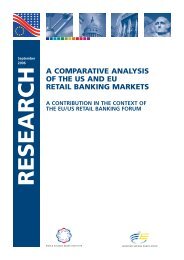Corporate Governance and Access to Finance - ESBG
Corporate Governance and Access to Finance - ESBG
Corporate Governance and Access to Finance - ESBG
Create successful ePaper yourself
Turn your PDF publications into a flip-book with our unique Google optimized e-Paper software.
Chart 3.Percent of Total adults who do not use formal financialservices by regionSource: own elaboration from Financial <strong>Access</strong> Initiative (www.financialaccess.org).The average size of deposits is also considered a relevant indica<strong>to</strong>r foraccess. The rationale is that, as the financial system reaches progressivelylower segments of the population, the accounts tend <strong>to</strong> have a smalleraverage size. This relationship may be affected by the existence of dormantaccounts, the co-existence of household <strong>and</strong> business accounts, <strong>and</strong>variations on the average number of deposits that a person holds, estimatedby CGAP, as mentioned above, in 3. Also, <strong>to</strong> facilitate internationalcomparison, the average size of deposits is corrected by per capitaincome, as an indica<strong>to</strong>r of the countries level of development.As in the case of deposits, a higher average loan size is generally interpretedas reflecting a bias <strong>to</strong>wards higher income cus<strong>to</strong>mers. As financialdeepening advances <strong>and</strong> financial markets develop, more people haveaccess <strong>to</strong> credit <strong>and</strong> the size of the average loan (relative <strong>to</strong> the country’sper capita income, as in the case of deposits) decreases.For the purpose of the present study, <strong>and</strong> in line with other internationalreports, the three abovementioned indica<strong>to</strong>rs of <strong>Access</strong> <strong>to</strong> <strong>Finance</strong> areused: (i) the number of deposits per 1,000 adults, (ii) the average size ofdeposits <strong>and</strong>, for those WSBI members that provide credit, (iii) theaverage size of loans. Table 10 presents a summary of the relevant dataon <strong>Access</strong> <strong>to</strong> <strong>Finance</strong> provided by the five selected Case Studies.72
















